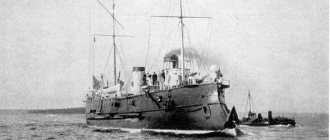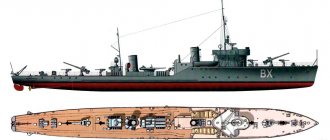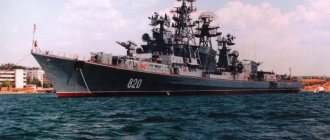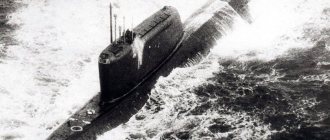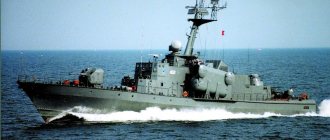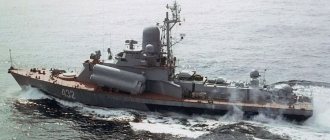In the domestic fleet today there is a steady confrontation between two different concepts of fleet development. One group of military sailors from among tacticians and strategists is focused on creating universal ships of small and medium displacement for the fleet. Based on the composition of their weapons and their tactical and technical characteristics, such ships can perform a huge amount of work, from conducting strike operations to carrying out search and patrol operations. The main argument of supporters of this concept is the low cost of building such ships and the real opportunity to master mass production. The Russian Navy today really needs modern ships, and in large quantities.
Leader
The period has come when the rich heritage of the Soviet Navy has really exhausted its service life and a full replacement of the ship's personnel is required. Another group of naval strategists is gravitating towards creating a powerful ocean-going fleet in Russia, equipped with large warships. In this case, the naval leadership’s desire for gigantomania, preserved from the Soviet period, is reflected. The main argument of the supporters of this concept is banally simple and relies more on ideological motives. A large country means you need to have a large fleet equipped with large combat vessels. The destroyer project 23560 is a clear confirmation of this. The history of the birth of the project and subsequent events clearly showed how ready the domestic shipbuilding and defense industry is to implement such large-scale plans. The designed ship should be the response of the domestic fleet to the appearance in the ranks of Western fleets of similar ships, the American destroyer Zamvolt and the British destroyer Daring.
Zumwalt
The new ship is a kind of test of suitability for the Russian defense industry. The performance characteristics included in the project are the most advanced for military vessels today. Is the domestic industry capable of mastering the construction of new promising ships for the fleet in the required quantities, or will the Leader-class destroyer become another leviathan in the Russian navy?
The birth of project 23560 “Leader” - where the legs grow from
The Russian Supreme Naval leadership has set an ambitious task for Russian designers to create a large warship, the design of which will embody all the advanced concepts and the most modern technologies. The new destroyer should be smaller than domestic heavy cruisers of the Kirov class, but larger in size than the American destroyer Zamvolt.
It is planned to use a nuclear power plant on the ship, which will significantly increase the range and operational life. The American ship has a conventional power plant. In terms of technical equipment, power supply and combat equipment, the Russian ship should become more powerful than its American counterpart. Already assessing the preliminary tactical and technical characteristics included in the project, we can safely say that typical elements of the next arms race are visible. Project 23560 is another attempt to catch up and technically surpass Western military fleets. How successful this idea is is difficult to judge now, but there are reasons why the construction of a vessel of this class for the Russian fleet remains open.
Project 23560 destroyer diagram
It should be noted that such large military vessels have not yet been built at Russian shipyards under modern conditions. There is experience in modernizing large Soviet-built ships, which they are trying to use for the development and construction of a new destroyer. A promising ship may surprise even a specialist privy to the intricacies and details of the development of modern military fleets. The ship's design incorporates a number of advanced technical innovations. Providing the ship with radar and navigation equipment deserves a separate discussion. Stealth technology dominates the entire project. On top of that, the Russian Leader-class destroyer must be armed with the most advanced and powerful types of weapons, surpassing all domestic ships in combat capabilities.
The multi-purpose destroyer was developed for operations in the far sea zone. The ship's functions included combating land ships of all classes, providing anti-submarine and air defense for the formation of ships, and fire support for landing operations. Assessing the functionality of the ship, its technical characteristics and combat capabilities, a reasonable question arises - why a destroyer. In terms of displacement and size, the designed ship is more reminiscent of a cruiser. All of the above functions were previously assigned to the cruiser.
Japanese brother "Kongo"
It is generally accepted that a modern destroyer is a universal ship, but at the same time, a full-fledged fleet of a particular country orders ships, so to speak, with a national flavor or a bias in versatility for solving basic tasks. The most important priority of the Russian fleet in the north and in the Pacific Ocean has been and remains to ensure the deployment and cover of strategic missile carriers in the bastions. And if for anti-submarine helicopters and coastal patrol aircraft the very presence in the area of a modern destroyer with a long-range air defense system on board will already be a strong argument for caution, then for hunting submarines this is a typical task. And the number of such boats and their combat qualities among potential adversaries currently significantly exceeds the capabilities of our fleet in the fight against them.
The everyday probability of a duel with an enemy submarine for our destroyer (as part of a KUG, AUG) during an amphibious operation or autonomous navigation is still higher than repelling a star raid by carrier-based aircraft or anti-ship missiles. Therefore, the specificity of our ship should be readiness for anti-submarine defense while performing any other tasks.
We do not need to invent an adequate mission by sending a destroyer to the shores of Florida or California, as the United States does off the coast of Crimea or the Persian Gulf. And the best air defense destroyer in the Western world in the British Royal Navy, the Daring class, is not suitable for us. The Germans will also disappoint us with their universal frigate in the size of the destroyer F125 Baden-Württemberg-Klasse (Die Baden-Württemberg-Klasse) with the goals of our project 22160. Perhaps, we will find the greatest similarity with our specifics in the Japanese destroyers of the Atago and Atago types. "Kongo" (The Kongō class).
Atago-class destroyer Ashigara DDG178, further development of the Kongo class
A small digression. Why a destroyer?
When creating a new promising destroyer, Russian designers followed a well-trodden path that had been successful in other countries. The “small fleet effect”, which Japan has been implementing for 50 years, probably worked here. After defeat in World War II, Japan lost its entire battleship and cruiser fleet. In the process of reviving the fleet, the concept of building small-displacement military vessels was adopted. The main combat vessel of the Japanese Self-Defense Navy was considered a destroyer-class ship. Over time, Japanese designers and sailors developed the destroyer concept, turning it into a completely different ship. Today, the Japanese Navy has aircraft carrier destroyers and landing craft destroyers. The displacement of these combat units has far exceeded the threshold that was established for ships of this class. Currently, destroyers have a displacement of 10-15 thousand tons.
Japanese destroyer aircraft carrier
Thus, the Japanese military decided to circumvent restrictions on the military budget. It is much easier to obtain funding for the construction of a destroyer than to provide funding for a cruiser under construction, much less an aircraft carrier. It doesn’t matter that during the construction process, a modest destroyer turns into a warship comparable in combat power and size to a battleship. This practice bore fruit and in a short time Japan was able to acquire an entire squadron of large ships of various classes, which, with a stretch, can be called destroyers.
They decided to take a similar route to the USA, where they decided to build the latest ships in a similar way. Having included in the draft military budget the construction of a new destroyer, the Americans ended up with a combat vessel comparable in size and combat power to a cruiser. The British also managed to build a new ship of type 45, which is considered a destroyer, but in fact is quite comparable to a full-fledged cruiser.
Daring
The domestic fleet did not reinvent the wheel and relied on creating a project for a promising warship. The Project 23560 destroyer is a completely different type of combat vessel, which was previously built at domestic shipyards. In terms of armament power and combat equipment, this ship is comparable to the domestic Kirov-class nuclear-powered heavy cruisers. The design cost in this case is significantly lower, which makes it possible to build such ships in a large series.
Eight years before the test
So, at present we can say with confidence that the Russian military-industrial complex is able to create a modern ship of the destroyer class at the level of world developments. Since 2014, the pain points of our military shipbuilding have been systematically eliminated: the lack of engines for warships and the lag behind the level of world developments in our own electronics for weapons systems.
Of the ship's entire set of weapons, a range of missiles for long-range air defense systems, compatible with the UKSK launcher, must be developed almost from scratch. (If the justification for the presence of two different vertical launchers on a ship can be their optimization for such different weight and size characteristics of products such as 9M100 and 3M55, then the author could not come up with such a justification for the appearance of a third type of vertical launcher for the DB missile defense system).
The key to the success of the implementation of the Project 11552 destroyer is the minimum level of the latest developments, which will require significant financial costs and constant time shifts to the right for the commissioning of the ships themselves. The Leader destroyer project has been discussed for eight years now. In eight years, Project 11552 may already be tested. The main question remains to be resolved: does the fleet need a new destroyer at all?
The fate of Project 23560 Leader-class destroyers
From all the enormous amount of information about the project that is currently circulating in the press, on the Internet and on television, only a few details can be gleaned. It is planned that the newest Russian ship will be completely manufactured taking into account stealth technology. This concerns the use of composite materials in the construction of the main superstructures to give the vessel hull optimal contours. The Project 23560 destroyer will be characterized by a high degree of automation of all major technological and combat processes. The nuclear power plant and large dimensions of the vessel will provide it with unlimited seaworthiness and cruising range. The newest ship should reach a speed of up to 30 knots. In addition to strike and defensive weapons, it is planned to install hangars and take-off pads on the ship for basing and receiving two helicopters.
With such technical characteristics and parameters, the ship's displacement inevitably increases, which, in accordance with the design data, can be about 9 thousand tons.
Initially, the state of the newest ship looked like this. Even in the high offices of the Navy General Staff, there was a debate about what the new generation destroyer should become, and in the depths of the Northern Design Bureau, preliminary work on the development of the project was already underway. The idea of building such a ship for the domestic fleet appeared back in 2009, and only in 2013 was the preliminary design of the new vessel approved.
Sketch
The reason for this delay was that there was no consensus among either the sailors or the designers regarding the type of power plant for the new combat unit. Two concepts were fought: to give preference to a nuclear power plant or to concentrate efforts on building ships with a conventional gas turbine engine. Accordingly, the choice in favor of one or another option inevitably led to a change in the basic parameters of the vessel. With a nuclear power plant, the ship's displacement increased significantly. We were talking about 12-14 thousand tons. With a conventional engine, the ship could theoretically fit into the design parameters, about 9 thousand tons.
It should be noted here that time has put everything in its place. While they were deciding what engines the new destroyer would be equipped with, the military-political and economic situation in the world changed. Ukraine’s refusal to supply gas turbine units for the construction of Russian ships led to the decision to orient the project of a Leader-class destroyer to a nuclear power plant. The project was planned to be prepared taking into account the new requirements in 2022, but during this time it was only possible to begin full-fledged design work.
Despite this, already in 2022 at the International Salon, where samples of naval weapons were presented, Russia presented a model of the Project 23560E ship, a promising destroyer in an export version. At this salon, the tactical and technical data that the new ship will have to have were only announced. As for the external appearance, it turned out that the model of the ship presented at the exhibition only conditionally reminds of a new development of the Russian defense industry.
Project 23560E destroyer
In the export version, the promising ship should carry 64 launchers for Brahmos, Kalibr-NK or Zircon anti-ship missiles. 56 launchers of the naval version of the S-400 air defense system or a more modern modification of the S-500 Prometheus were responsible for the air defense on the ship. Further, the ship's firepower was enhanced by the installation of launch containers for the Redut anti-aircraft missile system.
In terms of combat power, the Russian project surpassed all currently existing military vessels. The strike complex, combined with a powerful air defense system, made such a ship the most formidable enemy at sea. As befits a ship of this class, the Leader-class destroyer was also equipped with torpedo weapons. Traditionally, they decided to leave artillery on the ship, which is represented by an automatic 130 mm cannon in a turret.
Far Eastern Four
One of the main fair arguments against the construction of a new nuclear-powered aircraft carrier for the Pacific Fleet of the Russian Federation is considered to be the lack of escort ships for the future carrier strike group.
And the fact that four full-fledged modern destroyers (of the first series) in the Far East will clearly be in demand in ten years is beyond doubt both among specialists and experts, and among people who are not indifferent to the state of our fleet in general. Skeptics argue that today in Russia there is no place and no one to create a hull according to military standards for a nuclear-powered aircraft carrier with a length of 305 meters and a displacement of 70,000 tons. Something similar was created at the Ukrainian Nikolaev shipyards, technologies and competencies have been lost, there are no qualified personnel both at the work site and in the design bureau. From the last thing I learned: the secret of producing armored steel for the upper deck of an aircraft carrier has been lost. God bless him, with the aircraft carrier, with the cruiser (no one except us and the Americans has them), but is the destroyer “sustainable” or not? I will take the liberty of asserting that we not only can build it, but we must! I don’t like Hitler’s word “wunderwaffe” (from German wunderwaffe - “wonder weapon”). And you don’t need a masterpiece, for yourself, not for export. Thirty years ago, the hull of a Project 1155.1 ship was laid down at a shipbuilding plant in Kaliningrad, which was launched in 1994 under the name Admiral Chabanenko. The plant is native, Russian, and has been building warships ever since. And the time-tested hull of the latest Soviet BOD, with minimal modifications, will be suitable for the first Russian universal destroyer.
Project 1155.1 BOD "Admiral Chabanenko"
destroyers of the Arleigh Burke type for more than thirty years A similar stability of taste in the choice of hull is also shown for our (not dimensionless) financing of naval developments.
Arleigh Burke-class destroyer DDG111 "Spruance" series 2A
Mysteries of Project 23560 and the real state of affairs
In order to imagine the full scale of the construction underway, you need to understand one nuance. Why did a ship that was supposed to become a destroyer manage to turn into a ship comparable to a missile cruiser even at the design stage? The tasks that such a ship must solve seem excessive for one ship. In this case, the situation that arose in Japan with the construction of the battleships Yamato and Musashi, the largest military ships of this class, is comparable. An attempt to concentrate colossal firepower on one or two warships can result in disaster for the fleet.
The attempts of Russian naval sailors to create one or two large warships capable of gathering on board the firepower of an entire fleet look similar. Whether this will be justified from a tactical and operational point of view, time will tell. The situation is still in its infancy and the contract amounts that could result in the construction of Leader-class destroyers look exorbitant.
The primary task of equipping frigates
As the head of the department for the construction of warships, Anatoly Shlemov, reported to the media back in 2005: “the command of the Navy, based on naval science, adheres to the following plan: first it is necessary to commission corvettes, then frigates. And only after the naval forces are equipped with ships of this type, we begin to build a destroyer and an aircraft carrier.”
It is interesting that at the same time, the issue with corvettes is being resolved more or less successfully, but with the frigate type 22350 there was a significant delay. According to the official version, it was caused by disagreements between the Northern Shipyard plant and the author of the Almaz-Antey project.
Equipment layout diagram
Let us add here the information that the construction of one of the main ships, Admiral Gorshkov, which began almost 12 years ago, has not yet been completed due to the complexity of the work. Sounds like an excuse, doesn't it!? But let's continue to analyze the facts.
Despite the planned six ships of the 22350 class since 2013, none of them have been laid down at existing shipyards. At the same time, the prospects that this will happen in the near future are also not yet visible. Strange again.
At the same time, the media reported information about plans to build an improved modification of the Admiral Gorshkov under the code number “22350 M”. But this is not widely disclosed. All that is known:
- Its armament is greater than that of the Admiral Gorshkov;
- It is planned to play the role of the main frigate of the ocean waters;
- The displacement will be more than 5000 tons;
- Two shipyards are planning to carry out the construction: the St. Petersburg shipyard “Severnaya” and the Kaliningrad “Yantar” shipyard.
The “Plan for the Commissioning of Military Developments for 2018-2027” clearly outlined the emphasis: first, it is important to build nuclear and non-nuclear submarines. After that - coast guard frigates. This state of affairs means that the actual beginning of the creation of the “Leader” is shifted in time by 7 or even 10 years.
Battleship in miniature
Meanwhile, one modern Russian corvette has such weapons, the striking power of which is quite comparable not only with the corvettes of World War II, but with a good dozen destroyers of that time! To be more precise, it is simply incomparable, especially due to the Uran anti-ship missiles and the near-strategic Caliber cruise missiles. But then why is it just a “Corvette”?
The fire missions that this imaginary “corvette”, that is, a nominally small ship, is capable of performing, were perhaps not even capable of being handled by a battleship from the Second World War.
So the question arises - why so belittle, in the sense of classification, and even without any reason, our modern “corvettes” of this project, recognizing in advance the priority of NATO “destroyers” over them? Just because they are “thicker and heavier”? But should this be the main criterion for the class of ships?
© mil.ru
Russian "corvette" project 20380/20385.
Difficulties with construction sites
The second, no less important reason for the delay in the start of construction could be the actual lack of a construction site. Existing shipyards are not suitable for ships with unusually large displacement. And in the case of project 23560, based on official data announced by the now former deputy head of the defense department for technical support, Yuri Borisov, we are talking about 14,000 tons.
If we talk about dimensions, then it is approximately 199 meters in length, 22.5 in width, with a posture of 6.8 meters (according to the results of calculations, available drawings, as well as existing analogues in the fleet).
Shipbuilding facilities in Severodvinsk and the Far Eastern shipyards are still busy building submarines. The recently commissioned Kerch “Zaliv” is not yet ready. The Baltic Shipyard specializes in nuclear icebreakers. The Far Eastern Zvezda is under reconstruction.
The end of 2022 was significant for Northern Shipyard and Metrostroy. They finally signed a cooperation agreement, which envisages joint shipbuilding of large-displacement units. For this purpose, a site measuring 250 by 140 meters was even prepared.
Based on the results of studying Google satellite images, work has begun, although this is not widely advertised. Also, according to available data, the completion date for these activities is the first quarter of 2019.
New shipbuilding facilities in St. Petersburg are planned to be used for the construction of two landing helicopter carriers, and only after that - to carry out larger-scale tasks.
